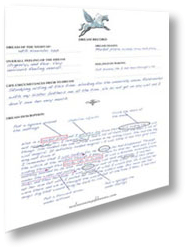|
[?]Subscribe To This Site
|
Learn How Easy Dream Interpretation is with Our Step By Step Tutorial
And as such, it is an invaluable tool for self-awareness. Learning dream analysis is teaching your awake brain to think like your dreaming brain. Now, this can seem like a challenge at first. However, once you have grasped the principles of dream interpretation it will become, as they say, “as easy as falling off a log”. In other words, fairly easy! On commencing dream analysis, it is important to understand that your dreams convey your underlying feelings and thoughts. Your dreams and the people who star in them, the actions, settings and feelings are all personal to you. Many dream researchers believe in universal dream symbols, that the images we see in our dreams are the same for everybody. However, we believe the same image can mean different things for different people. As such a book like a dream dictionary, which gives a very specific meaning for certain images, is usually not much use. The author of the dream dictionary was not the author of your dream. You were. By taking a closer look at your dreams and by trying to understand what particular images mean to you, and by trying to find some parallels between these images and your waking life, you will begin to understand the meaning of dreams.
I want to take you step by step through the process I use to interpret my dreams. This PDF is a complete interpretation of a dream from my personal journal using the techniques I am about to share with you. Refer to this example often as we move through the steps of the tutorial and you will gain a deeper understanding of the process involved.
To Record dreams is of vital importance to an accurate dream interpretation.But in order to record them you must remember them, right? How many of your night time escapades can you remember clearly? If you are anything like me, you will remember from 1-3 dreams every night, record all of them and begin the process of dream interpretation straight away.If not, all those wonderful images and adventures would be lost forever! So, the first step in recording your dreams obviously, is to remember them!We all dream, every night, each person will dream 3-20 times a night. Remembering and writing your dreams down is not only a great exercise for recording your dreams but it is also a wonderful tool for exercising the imagination. And for those of us who so seldom call upon our imagination in daily life, this is a precious skill to practice. If you have difficulty remembering your dreams, click here to read some valuable insights on how to improve your dream recall. Let’s assume now, you are remembering at least 1 dream a night.The next step of dream interpretation is to write the dream down as soon as you wake up. Recording your dream quickly when waking is of vital importance to this process.Within the first 5 minutes of waking you will forget 50% of your dream content, and then 90% will be forgotten after 10 minutes. So keeping a pen and paper by your bed will enable you to record your dreams on the spot. 
1. My dreams are in sequential order so dream interpretation is easy and any patterns that are emerging are easily identified.
Whatever way you choose to record your dreams, to begin with you will probably only be recording fragmentary images, and vague memories. This is normal! The longer you are recording and interpreting dreams the more and more you will begin to recall. Over time, your ability to recall dreams will become stronger and ultimately your dream interpretation skills will improve. Open the sample PDF to the first page, which is titled dream record. There are two parts of dream interpretation to be completed before you go to bed: The next step is recording the dream in as much detail as possible. Record how you felt in your dream, what you saw and what you did. Who else did you see in your dream? Did you know them or were they strangers? Feel free to express yourself in any way that is natural to you with your dream description. If you would prefer to draw then do so. A combination of drawing and writing is also a good method. Don’t try to be too neat here there is no need. Resist embellishment for the sake of a more interesting dream record. Avoid also trying to interpret dream symbols at this stage. Doing so too early on in the piece could lead to false conclusions and lead you in the wrong direction. These images show some creative ways to approach dream recording and that ultimately aid dream interpretation and definitely make it more fun! 
Be Creative! Enjoy the process and make it fun!
The next important step of dream interpretation is to identify your dream symbols. Dream symbols are any dream images that have played an important part in your dream. • Dream Stars
You can see in the example image to the left how we identified the dream symbols. This was just a funny little example to show you how to identify the dream symbols within your dream images. For a more concrete example refer to the PDF. See how we identified each dream symbol with a different marker?
The next step of dream interpretation involves writing a brief description on each of the dream symbols you have identified. As you do this bare the following questions in mind: • How you feel about this action/setting/object/person/feeling in waking life? • How you feel about this action/setting/object/person/feeling in the dream? • What purpose does this action/setting/object/person/feeling have in waking life? • What purpose does this action/setting/object/person/feeling have in the dream? • Are there any distinguishing features about this action/setting/object/person/feeling in the dream that stand out? Look closely at the dream analysis PDF example here for how I described all the dream symbols in the sample dream. It is much easier to know where the dream is going if it is all written down in front of you. Go into as much detail as you can. At first, when you have just started out interpreting dreams the more information you include the better off you will be able to discover the meaning of dreams.
Once you have your descriptions done, you can focus on identifying the theme of your dream. Every dream has a theme, and without understanding the theme you will be at a loss to understand the individual elements within. The theme of the dream example is being chased. Write down briefly what you feel the theme of your dream is.
Once you have your theme, you need to focus on how you felt the whole time this theme was playing out. What was the overall feeling of the dream? Was there desperation as you were searching for something you couldn’t find? Were you exhilarated at the new ability of flying you had just discovered? Were you scared because a vampire was chasing you? Write down briefly what the overall feeling of the dream was.
Now turn over your dream interpretation so far…no cheating! Ask yourself this question: In the PDF example I would be asking myself this question: If nothing comes to mind here, read back over the life description you entered prior to your dream record to see if that sparks any connections to pop into your mind. Once you have composed an answer in your head write it down. Now read over what you just wrote and then ask yourself, how this dream can shed light on what you are thinking and feeling about the situation you have described in the previous section? Remember that to become proficient at analyzing your dreams you need to practice. I hope you found this tutorial helpful. If you have any questions or find the information difficult to understand in any way, please contact us via the tab in the navigation bar.
|
|






